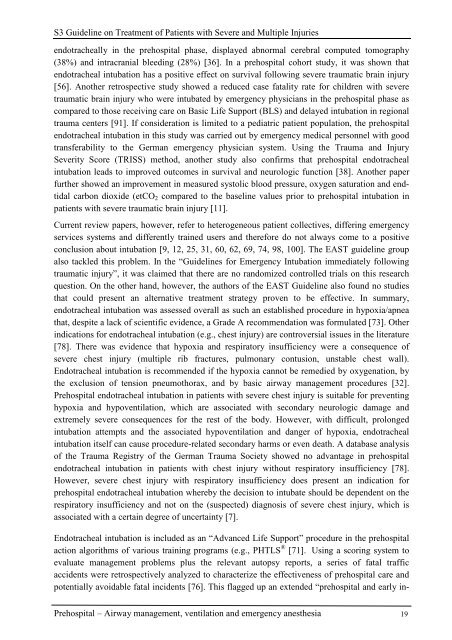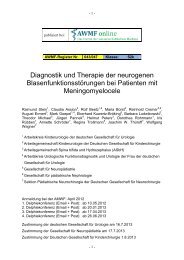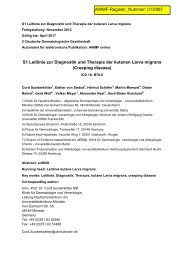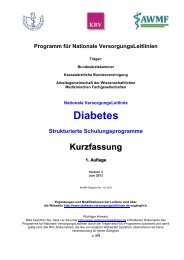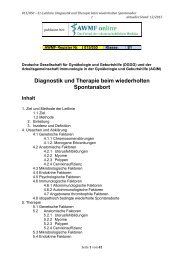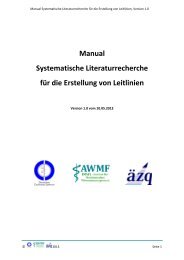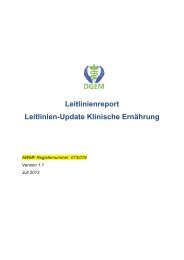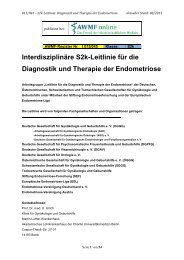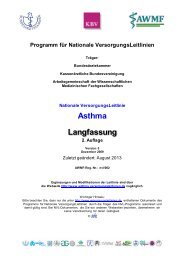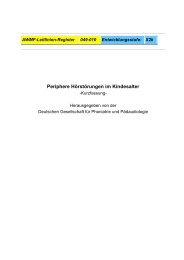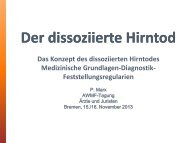Guideline on Treatment of Patients with Severe and Multiple ... - AWMF
Guideline on Treatment of Patients with Severe and Multiple ... - AWMF
Guideline on Treatment of Patients with Severe and Multiple ... - AWMF
You also want an ePaper? Increase the reach of your titles
YUMPU automatically turns print PDFs into web optimized ePapers that Google loves.
S3 <str<strong>on</strong>g>Guideline</str<strong>on</strong>g> <strong>on</strong> <strong>Treatment</strong> <strong>of</strong> <strong>Patients</strong> <strong>with</strong> <strong>Severe</strong> <strong>and</strong> <strong>Multiple</strong> Injuries<br />
endotracheally in the prehospital phase, displayed abnormal cerebral computed tomography<br />
(38%) <strong>and</strong> intracranial bleeding (28%) [36]. In a prehospital cohort study, it was shown that<br />
endotracheal intubati<strong>on</strong> has a positive effect <strong>on</strong> survival following severe traumatic brain injury<br />
[56]. Another retrospective study showed a reduced case fatality rate for children <strong>with</strong> severe<br />
traumatic brain injury who were intubated by emergency physicians in the prehospital phase as<br />
compared to those receiving care <strong>on</strong> Basic Life Support (BLS) <strong>and</strong> delayed intubati<strong>on</strong> in regi<strong>on</strong>al<br />
trauma centers [91]. If c<strong>on</strong>siderati<strong>on</strong> is limited to a pediatric patient populati<strong>on</strong>, the prehospital<br />
endotracheal intubati<strong>on</strong> in this study was carried out by emergency medical pers<strong>on</strong>nel <strong>with</strong> good<br />
transferability to the German emergency physician system. Using the Trauma <strong>and</strong> Injury<br />
Severity Score (TRISS) method, another study also c<strong>on</strong>firms that prehospital endotracheal<br />
intubati<strong>on</strong> leads to improved outcomes in survival <strong>and</strong> neurologic functi<strong>on</strong> [38]. Another paper<br />
further showed an improvement in measured systolic blood pressure, oxygen saturati<strong>on</strong> <strong>and</strong> endtidal<br />
carb<strong>on</strong> dioxide (etCO2 compared to the baseline values prior to prehospital intubati<strong>on</strong> in<br />
patients <strong>with</strong> severe traumatic brain injury [11].<br />
Current review papers, however, refer to heterogeneous patient collectives, differing emergency<br />
services systems <strong>and</strong> differently trained users <strong>and</strong> therefore do not always come to a positive<br />
c<strong>on</strong>clusi<strong>on</strong> about intubati<strong>on</strong> [9, 12, 25, 31, 60, 62, 69, 74, 98, 100]. The EAST guideline group<br />
also tackled this problem. In the “<str<strong>on</strong>g>Guideline</str<strong>on</strong>g>s for Emergency Intubati<strong>on</strong> immediately following<br />
traumatic injury”, it was claimed that there are no r<strong>and</strong>omized c<strong>on</strong>trolled trials <strong>on</strong> this research<br />
questi<strong>on</strong>. On the other h<strong>and</strong>, however, the authors <strong>of</strong> the EAST <str<strong>on</strong>g>Guideline</str<strong>on</strong>g> also found no studies<br />
that could present an alternative treatment strategy proven to be effective. In summary,<br />
endotracheal intubati<strong>on</strong> was assessed overall as such an established procedure in hypoxia/apnea<br />
that, despite a lack <strong>of</strong> scientific evidence, a Grade A recommendati<strong>on</strong> was formulated [73]. Other<br />
indicati<strong>on</strong>s for endotracheal intubati<strong>on</strong> (e.g., chest injury) are c<strong>on</strong>troversial issues in the literature<br />
[78]. There was evidence that hypoxia <strong>and</strong> respiratory insufficiency were a c<strong>on</strong>sequence <strong>of</strong><br />
severe chest injury (multiple rib fractures, pulm<strong>on</strong>ary c<strong>on</strong>tusi<strong>on</strong>, unstable chest wall).<br />
Endotracheal intubati<strong>on</strong> is recommended if the hypoxia cannot be remedied by oxygenati<strong>on</strong>, by<br />
the exclusi<strong>on</strong> <strong>of</strong> tensi<strong>on</strong> pneumothorax, <strong>and</strong> by basic airway management procedures [32].<br />
Prehospital endotracheal intubati<strong>on</strong> in patients <strong>with</strong> severe chest injury is suitable for preventing<br />
hypoxia <strong>and</strong> hypoventilati<strong>on</strong>, which are associated <strong>with</strong> sec<strong>on</strong>dary neurologic damage <strong>and</strong><br />
extremely severe c<strong>on</strong>sequences for the rest <strong>of</strong> the body. However, <strong>with</strong> difficult, prol<strong>on</strong>ged<br />
intubati<strong>on</strong> attempts <strong>and</strong> the associated hypoventilati<strong>on</strong> <strong>and</strong> danger <strong>of</strong> hypoxia, endotracheal<br />
intubati<strong>on</strong> itself can cause procedure-related sec<strong>on</strong>dary harms or even death. A database analysis<br />
<strong>of</strong> the Trauma Registry <strong>of</strong> the German Trauma Society showed no advantage in prehospital<br />
endotracheal intubati<strong>on</strong> in patients <strong>with</strong> chest injury <strong>with</strong>out respiratory insufficiency [78].<br />
However, severe chest injury <strong>with</strong> respiratory insufficiency does present an indicati<strong>on</strong> for<br />
prehospital endotracheal intubati<strong>on</strong> whereby the decisi<strong>on</strong> to intubate should be dependent <strong>on</strong> the<br />
respiratory insufficiency <strong>and</strong> not <strong>on</strong> the (suspected) diagnosis <strong>of</strong> severe chest injury, which is<br />
associated <strong>with</strong> a certain degree <strong>of</strong> uncertainty [7].<br />
Endotracheal intubati<strong>on</strong> is included as an “Advanced Life Support” procedure in the prehospital<br />
acti<strong>on</strong> algorithms <strong>of</strong> various training programs (e.g., PHTLS ® [71]. Using a scoring system to<br />
evaluate management problems plus the relevant autopsy reports, a series <strong>of</strong> fatal traffic<br />
accidents were retrospectively analyzed to characterize the effectiveness <strong>of</strong> prehospital care <strong>and</strong><br />
potentially avoidable fatal incidents [76]. This flagged up an extended “prehospital <strong>and</strong> early in-<br />
Prehospital – Airway management, ventilati<strong>on</strong> <strong>and</strong> emergency anesthesia 19


